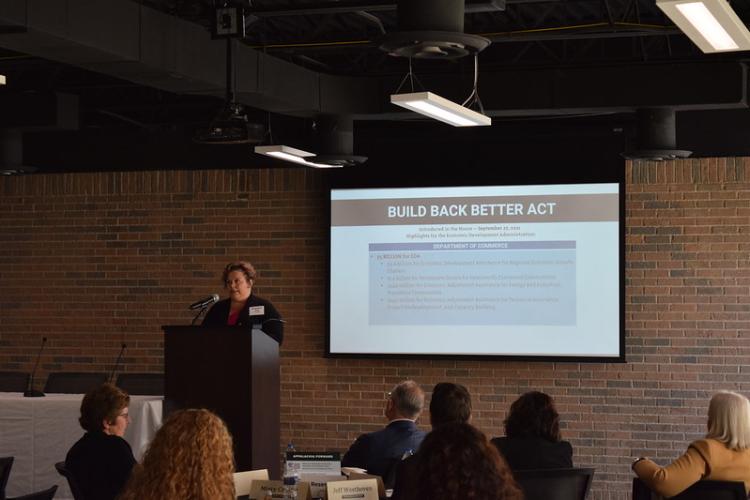
Appalachia Forward conference fosters connections, relationships between local and state governments

The Voinovich School of Leadership and Public Service at Ohio University recently hosted the Appalachia Forward conference at Hocking Lodge. Co-sponsored by the Governor’s Office of Appalachia, Buckeye Hills Regional Council, EastGate Council of Governments, Ohio Mid-Eastern Governments Association and the Ohio Valley Regional Development Commission, the Nov. 8 event provided resources for public officials and community leaders to navigate the vast array of funding available to the region.
“Ohio’s economy is very strong, the state of the region is very strong. I’m very excited about what’s happening, not only in Ohio, but what is happening here in the region,” Lydia Mihalik, director of the Ohio Department of Development, said in her opening remarks. “The economy is on the right path, and I’m very optimistic, quite frankly, about where we’re going.”
The conference covered a range of topics focused on developing the Appalachian region by taking advantage of federal and state support, including COVID-19 relief funding and capital bill dollars.
“The goal is for everyone to understand that we’ve never had the amount of funding that’s available to our region that we do right now,” said Tom Johnson, mayor of Somerset.
The conference was also livestreamed, and presentations from the event were made available at the Appalachia Forward website.
To summarize the event, Amista Lipot, executive director of external relations and strategic partnership at the Voinovich School and executive director of the Mayors’ Partnership for Progress, urged the participants to call and ask questions –– connecting with each other and agencies that could offer guidance.
“We heard ‘think regionally,’” Lipot said. “Don’t just confine yourself to your small community. Regionally, think of bigger impact and also build relationships. I think everybody in this room is probably really good at building relationships, but I’m going to challenge you to work at it a little bit harder, and more importantly, build relationships with your legislators so you can get things done next year and the year after.”
Greg Fraunfelter, mayor of the city of Logan, said the focus of the conference was “show me the money.” “Learning from where monies can be requested was an eye-opener, and I took lots of notes,” Fraunfelter said.
Mark Mills, mayor of Coshocton, said the conference was a great way to connect with the many layers of state government that support Appalachia. “What I see is everyone working together for a common goal of growth and prosperity within our region. That’s what’s going to make things happen. I think that’s what you’re beginning to see, so it’s exciting.”
POWER 2022
Representatives from the Governor’s Office of Appalachia hosted the first segment of the conference discussing upcoming applications for the Partnerships for Opportunity and Workforce and Economic Revitalization Initiative, which provides funds for areas negatively affected by changes to the coal and power industries.
The five goals of the initiative are: to build Appalachian businesses, Appalachia’s workforce ecosystem, Appalachia’s infrastructure, regional culture and tourism, and community leaders and capacity. The grants are up to $1.5 million with matching funds required and for projects taking 24 to 36 months to complete.
The POWER Technical Assistance Grants also are available, up to $50,000 with matching funds required, for projects that take a year to complete. These grants are specifically for economic development projects.
COVID Relief Opportunities
The Buckeye Hills Regional Council presented on the range of sources of funding that are available due to the coronavirus pandemic: the CARES Act, the American Rescue Plan Act, the Infrastructure Investment and Jobs Act as well as the Build Back Better Act.
The CARES Act was aimed at funding for specific organizations such as businesses and local governments to use in direct response to the pandemic. The American Rescue Plan Act has broader scope, and is being used in Ohio to create broadband expansion and water and wastewater infrastructure grants. The Infrastructure Investment and Jobs Act reserves 25% of the total Ohio allotment for the new rural surface grant program. The Building Back Better Act will distribute funds to a range of economic growth programs.
Creative Community Revitalization
The Creative Community Revitalization segment of the conference provided information on how different programs in the state can help local areas revitalize themselves, such as the Ohio Arts Council providing funding for community art.
The Vibrant Communities program emphasizes the development of downtowns to “attract and maintain talent,” Kristi Tanner of Jobs Ohio said. Amanda Terrell of the Ohio History Connection said that historic buildings are assets to the community and can provide real economic benefit.
Joyce Barrett of Heritage Ohio talked about the four-point Main Street approach to revitalizing a downtown of a local area. The four points are: economic vitality, design, organization and promotion.
All of the programs offered grants for a range of services, and more information can be found at the link to Appalachia Forward.
Capital Bill
The capital bill segment informed attendees about grants eligible for cultural projects as part of the capital bill appropriations process.
The grants would support “culture over a 10-year period,” according to the Ohio Facilities Construction Commission (OFCC) presentation by Jeffrey Westhove, chief of program services at the OFCC.
Grants are available to government organizations, nonprofits that provide culture activities and regional arts and cultural districts. Projects that deal with the arts, science or history are all eligible for the grant, which can be used for design services, new construction, renovation, labor and acquisition of property.
The program requires matching funding of $1 for every $2 supplied through the grant.
